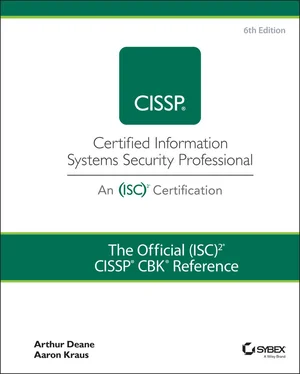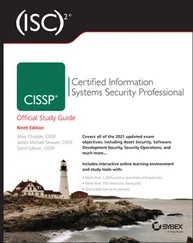1 ...8 9 10 12 13 14 ...35 Understand, agree to, and adhere to all information security policies, procedures, standards, and guidelines, as well as any relevant regulatory and compliance requirements. Users are also responsible for satisfying contractual obligations (such as nondisclosure agreements) that affect the confidentiality of the company's information and processes.
Complete all required information security training and awareness activities by their required completion dates.
Report any actual or suspected security violations or breaches to appropriate personnel in a timely manner.
Security Control Frameworks
Poor security management is one of the primary culprits for many organizations' security problems. Security management can be accomplished by adopting a top-down approach, bottom-up approach, or some combination of the two.
Historically, enterprises have utilized more of a bottom-up approach to security, in which the IT department takes security seriously and attempts to develop a security function for the company. With this approach, operations staff identify security needs and issues and push those findings up the chain to senior management to provide guidance and funding. This approach tends to result in a company taking reactive measures rather than instituting proactive policies, and often leads to underfunded security programs.
In a top-down approach , senior leadership starts by understanding the regulations and security threats faced by the organization, and initiates strategies, policies, and guidelines that are pushed down throughout the rest of the organization. With a top-down approach, information security is evangelized by the most senior executives at the company, which ensures that security is prioritized and in alignment with the company's overall business strategy. An effective top-down approach requires strong governance (as discussed earlier in this chapter) that starts with aligning with one or more security control frameworks.
A security control is a technical, operational, or management safeguard used to prevent, detect, minimize, or counteract security threats. (ISC) 2defines a security control framework as “a notional construct outlining the organization's approach to security, including a list of specific security processes, procedures, and solutions used by the organization.” Organizations often adopt a security control framework to assist with meeting legal and regulatory compliance obligations, while also helping to build a security program that maintains the confidentiality, integrity, and availability of the company's assets.
NOTETechnical controls are system-based safeguards and countermeasures — things like firewalls, IDS/IPS, and data loss prevention (DLP). Operational controls are safeguards and countermeasures that are primarily implemented and executed by people (as opposed to systems); security guards are a common example. Management controls include policies, procedures, and other countermeasures that control (or manage) the information security risk. Management controls are sometimes referred to as administrative controls , but this should not be confused with activities associated with a system admin (sysadmin). The lines between the three categories can often blur (i.e., many controls fit into more than one of the categories), and many organizations have discontinued use of the terms to avoid confusion. You should be familiar with the concepts, should you come across the terminology in your organization.
Organizations often select security control frameworks based on their industry. For example, the Payment Card Industry (PCI) control framework is a global framework used by financial services organizations and companies that handle cardholder data. In the United States, the Health Insurance Portability and Accountability Act (HIPAA) offers a control framework for healthcare organizations and companies that handle protected health information (PHI). Aside from PCI and HIPAA (which are covered later in this chapter), ISO/IEC, NIST, and CIS provide some of the most frequently adopted security control frameworks used by organizations across multiple industries. While there are many other control frameworks available, you should be familiar with the following frameworks, at a minimum:
ISO/IEC 27001
ISO/IEC 27002
NIST 800-53
NIST Cybersecurity Framework
CIS Critical Security Controls
NOTEThe HITRUST (originally known as the Health Information Trust Alliance) Common Security Framework (CSF) was originally developed to address the overlapping regulatory environment in which many healthcare providers operate. It has evolved over time to provide a comprehensive, prescriptive framework that can be used for organizations that exchange any type of sensitive and/or regulated data. Taking into account both risk-based and compliance-based considerations, the HITRUST provides an auditable framework for the evaluation of an organization's security environment.
NOTEControl Objectives for Information Technologies (COBIT) is a framework developed by ISACA (previously known as the Information Systems Audit and Control Association) for overall information technology management and governance and is perhaps the most popular IT governance framework used in industry. While it is not a security-specific control framework, it does outline end-to-end IT governance objectives and processes that encompass many security requirements and concepts. Visit www.isaca.orgif you want to learn more about the COBIT framework.
ISO/IEC 27001 (sometimes referred to as just ISO 27001) is an information security standard published by the International Organization for Standardization (ISO) and the International Electrotechnical Commission (IEC). ISO 27001 is the most popular standard within the ISO/IEC 27000 family of standards and is focused on the creation and maintenance of an information security management system (ISMS), which ISO defines as “a systematic approach to managing sensitive company information so that it remains secure.” In plain English, an ISMS is a set of people, processes, and technologies that manages the overall security of a company's systems and data. ISO/IEC 27001 describes the overall components of an ISMS, and this standard is the basis for many organization's security programs.
As of this writing, the most recent revision to ISO/IEC 27001 was in 2013, though its parent, ISO/IEC 27000, was revised in 2018. ISO 27001:2013 contains 114 controls across 14 domains, as follows:
Information security policies
Organization of information security
Human resource security
Asset management
Access control
Cryptography
Physical and environmental security
Operations security
Communications security
System acquisition, development, and maintenance
Supplier relationships
Information security incident management
Information security aspects of business continuity management
Compliance
ISO/IEC 27002 (again, often referred to as just ISO 27002) is titled “Security Techniques — Code of practice for information security controls.” This standard builds on ISO 27001 by providing guidelines for organizations to select, implement, and manage security controls based on their own security risk profile. In other words, ISO 27002 is a bit more prescriptive than ISO 27001, as it provides best-practice recommendations for organizations to build and maintain their ISMSs.
The National Institute of Standards and Technology is a nonregulatory agency of the U.S. Department of Commerce, whose mission is to promote innovation and industrial competitiveness by advancing standards and technologies. NIST publishes and manages a variety of special publications related to information security, cloud computing, and other technologies. NIST 800-53, “Security and Privacy Controls for Federal Information Systems and Organizations,” is NIST's massive security control framework. Though NIST 800-53 was initially created to aid U.S. government agencies in managing their security programs, it is widely regarded as one of the most comprehensive baselines of security controls and is referenced across many industries around the globe. NIST 800-53 defines hundreds of security controls across the following 18 control families:
Читать дальше












